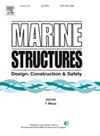Efficient long-term extreme response and fatigue analysis of offshore structures under stochastic wave, current and wind loads
IF 5.1
2区 工程技术
Q1 ENGINEERING, CIVIL
引用次数: 0
Abstract
Offshore structures face complex and stochastic loads from waves, current, and wind. An accurate long-term analysis is crucial for reliability assessment for overloading and fatigue failures. This problem is challenging due to the small probabilities and numerous uncertainties, thus existing methods mostly rely on simplifications or empirical rules. To address these challenges, this paper presents a new method for long-term extreme response and fatigue analysis, incorporating seven long-term environmental variables following a prescribed joint distribution and short-term uncertainties from irregular waves. The method combines subset simulation (SS) for efficient reliability analysis of rare events and an advanced metamodel GE-NARX for predicting the time series response for a wide range of environmental inputs. A new design-of-experiments scheme is developed to train the metamodel effectively. Another novel aspect is the application of SS to efficiently evaluate not only the failure probabilities but also the mean damage. The proposed method is tested on a floating system and shown to accurately predict the long-term extreme response and cumulative fatigue damage when compared with a time-consuming benchmark method, while offering a substantial computational speedup. The proposed method is highly efficient, allowing the investigation of diverse scenarios for better insight. Among other things, the results reveal the critical role of wave, current and wind directionality, and assuming deterministic values for wave, wind and current parameters can be substantially erroneous, highlighting the limitations of design codes. The proposed method is an effective tool for design and potentially for real-time risk assessment of offshore structures.
海上结构在随机波、流、风荷载作用下的有效长期极端响应和疲劳分析
海上结构面临着来自海浪、海流和风的复杂和随机载荷。准确的长期分析对超载和疲劳失效的可靠性评估至关重要。由于概率小,不确定性多,这一问题具有挑战性,因此现有的方法大多依赖于简化或经验规则。为了应对这些挑战,本文提出了一种长期极端响应和疲劳分析的新方法,该方法结合了遵循规定联合分布的七个长期环境变量和不规则波浪的短期不确定性。该方法结合了子集模拟(SS)对罕见事件进行有效的可靠性分析,以及先进的元模型GE-NARX,用于预测大范围环境输入的时间序列响应。为了有效地训练元模型,提出了一种新的实验设计方案。另一个新颖的方面是应用SS不仅可以有效地计算失效概率,还可以有效地计算平均损伤。该方法在浮式系统上进行了测试,结果表明,与耗时的基准方法相比,该方法可以准确地预测长期极端响应和累积疲劳损伤,同时大大提高了计算速度。所提出的方法是高效的,允许调查不同的场景,以获得更好的洞察力。除其他外,结果揭示了波浪,电流和风向的关键作用,并且假设波浪,风和电流参数的确定性值可能是严重错误的,突出了设计规范的局限性。该方法是海上结构物设计和实时风险评估的有效工具。
本文章由计算机程序翻译,如有差异,请以英文原文为准。
求助全文
约1分钟内获得全文
求助全文
来源期刊

Marine Structures
工程技术-工程:海洋
CiteScore
8.70
自引率
7.70%
发文量
157
审稿时长
6.4 months
期刊介绍:
This journal aims to provide a medium for presentation and discussion of the latest developments in research, design, fabrication and in-service experience relating to marine structures, i.e., all structures of steel, concrete, light alloy or composite construction having an interface with the sea, including ships, fixed and mobile offshore platforms, submarine and submersibles, pipelines, subsea systems for shallow and deep ocean operations and coastal structures such as piers.
 求助内容:
求助内容: 应助结果提醒方式:
应助结果提醒方式:


